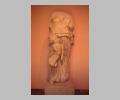
Marble statue of Prokne and Itys, from the Akropolis, perhaps by Agorakrit...
| Collection: | Athens, Acropolis Museum |
| Title: | Procne and Itys |
| Context: | From Athens, Acropolis |
| Findspot: | Found at Athens, Acropolis, near the West bastion of the Propylaia/Nike Temple (in 1836); the head was found later. |
| Summary: | A child leaning against his mother's leg |
| Object Function: | Votive |
| Sculptor: | Suggested attribution to Alkamenes |
| Material: | Marble |
| Sculpture Type: | Free-standing statue |
| Category: | Single monument |
| Style: | High Classical |
| Technique: | In-the-round |
| Original or Copy: | Original |
| Date: | ca. 425 BC |
| Dimensions: | H. (without head) 1.63 m; W. 0.58 m; Th. 0.44 m |
| Scale: | Life-size |
| Region: | Attica |
| Period: | High Classical |
Subject Description: According to a story popular in tragedies of the 420s (by Sophocles and Philokles) Procne, the Athenian princess, planned revenge on her husband, King Tereus of Thrace, who had betrayed her: she planned to murder their son Itys and to feed him to Tereus. Procne is shown here in a maternal outfit: she wears a belted Doric peplos and a shawl-like himation. She rests her weight on her left leg and turns her body slightly to the left. She holds her right arm at her side and raises her left hand, in which she may have held a knife. Itys, a nude boy, seeks refuge in the skirts of his mother.
Form & Style: Although the workmanship is less than perfect, the style corresponds to the time of Alkamenes, the pupil of Pheidias, and it is tempting to ascribe this work to his hand, as it was dedicated by a certain Alkamenes, according to Pausanias.
Condition: Nearly complete
Condition Description: Comprised of two pieces that do not join. The head, of which only the right side is missing, seems slightly larger in proportion to the body. The body lacks the neck, toes, right arm, and left hand of the mother; legs below the thighs, right arm, right hip, and face of the boy. Some of the drapery has chipped off.
Material Description: Coarse-ground, perhaps Island marble
Other Notes: Praschniker associated the head with the statue, although its connection to the body has been disputed by Berger.
Sources Used:
Other Bibliography: Hesperia 15 (1946) 10; E. Langlotz, "Alkamenesprobleme," BWPr 108, 15; E. Berger, AM 1956, 164; C. Praschniker, ÖJh 1913, 121, figs. 61 ff., pl.